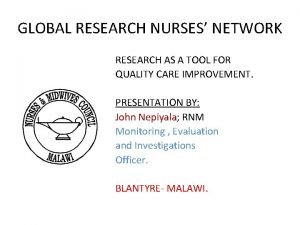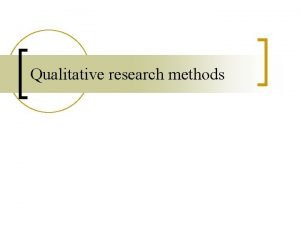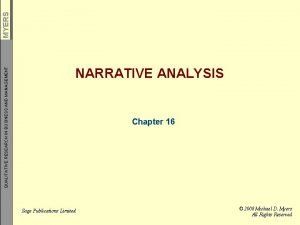2 a WHO of RESEARCH Yosa A Alzuhdy


































- Slides: 34

2 a. WHO of RESEARCH © Yosa A. Alzuhdy – ©FBS-UNY Yosa A. Alzuhdy - UNY Quantitative Research © Yosa A. Alzuhdy, M. Hum. yosa@uny. ac. id English Language and Literature Study Program Yogyakarta State University

Research Process © Yosa A. Alzuhdy - UNY

Three questions to begin: 3 © Yosa A. Alzuhdy - UNY

WHO? Sampling Often the groups sociologists want to study are so large or so dispersed that research on the whole group is impossible. © Yosa A. Alzuhdy - UNY To construct a picture of the entire group, they take data from a subset of the. ÿ A sample is any subset of a population. ÿ A population is a relatively large collection of people, the universe of the people, that a researcher studies and about which generalizations are made.

Sampling © Yosa A. Alzuhdy - UNY Ø Many situations where not possible to study the entire population Ø A sample is a finite part of a population whose properties are studied to gain information about the whole. Ø Subset of population can be used to make generalizations ÿ Must be representative of total population ÿ See all characteristics of total population in same relationship ÿ Microcosm of total population

6 Sampling Strategy Ø The degree to which your sample mirrors the population from which it comes will depend to a large extent on your sampling strategy. Ø The sampling strategy is the way in which you select units from the population for inclusion into your study. © Yosa A. Alzuhdy - UNY Why is this important?

Why is sampling important? 7 © Yosa A. Alzuhdy - UNY

8 © Yosa A. Alzuhdy - UNY

Sample Quant. Research 9 © Yosa A. Alzuhdy - UNY

Sampling Frame 10 Sampling Frame: A list of all the individuals (units) in the population from which the sample is taken; the actual list of sampling units (or elements). Examples of Sampling Frames: © Yosa A. Alzuhdy - UNY ü ü ü Students of Yogyakarta State University List of businesses registered with the Chamber of Commerce The phone book List of students served by the ILLC List of labor migrants registered with authorities in a particular city

Sampling Techniques NON-RANDOM SAMPLING (Non-Probability): each member of the sampling frame does not have an equal chance of being selected as a participant in the study. ÿ Convenience Sampling ÿ Snowball Sampling ÿ Purposive Sampling ÿ Quota Sampling ÿ Self-Selected/Voluntary © Yosa A. Alzuhdy - UNY RANDOM SAMPLING (Probability): each member of the sampling frame has an equal chance of being selected. ÿ Simple Random Sampling ÿ Stratified Random Sampling ÿ Systematic Sampling ÿ Cluster Sampling

Convenience Sampling 12 © Yosa A. Alzuhdy - UNY

13 Snowball Sampling ü Typically used in qualitative research ü When members of a population are difficult to locate, for covert sub-populations, non-cooperative groups ü Recruit one respondent, who identifies others, who identify still others, …. ü Primarily used for exploratory purposes © Yosa A. Alzuhdy - UNY

Snowball Sampling 14 © Yosa A. Alzuhdy - UNY

Why Snowball Sampling? 15 © Yosa A. Alzuhdy - UNY

16 Other Non-Probability Sampling PURPOSIVE SAMPLING ü Select the sample on the basis of knowledge of the population: suitability with the purpose, or use expert judges to identify candidates to select ü Typically used for very rare populations, such as deviant cases © Yosa A. Alzuhdy - UNY SELF-SELECTED/VOLUNTARY SAMPLING ü Give the candidates opportunity to voluntarily participate in a survey ü Provide questionnaires to be self-completed

17 Quota Sampling © Yosa A. Alzuhdy - UNY ü A stratified convenience sampling strategy ü Begins with a table that describes the characteristics of the target population ÿ e. g. the composition of postgraduate students at UNY in terms of faculty, race, and gender ü Then select on a convenience basis, postgraduate students in the same proportions regarding faculty, race, and gender than in the population ü Of course, the quota frame (the proportions in the table) must be accurate ü And biases may be introduced when selecting elements to study

Simple Random Sampling 18 © Yosa A. Alzuhdy - UNY

Selecting Simple Random Sample-MS Excel 19 © Yosa A. Alzuhdy - UNY

Selecting Simple Random Sample - SPSS 20 © Yosa A. Alzuhdy - UNY

Margin of Error 21 © Yosa A. Alzuhdy - UNY

Margin of Error 22 © Yosa A. Alzuhdy - UNY

23 © Yosa A. Alzuhdy - UNY

Stratified Random Sampling 24 © Yosa A. Alzuhdy - UNY

Systematic Sampling 25 © Yosa A. Alzuhdy - UNY

Cluster Sampling 26 © Yosa A. Alzuhdy - UNY

Generating a Random Sample 27 © Yosa A. Alzuhdy - UNY

Generating Random Number 28 © Yosa A. Alzuhdy - UNY

29 © Yosa A. Alzuhdy - UNY

30 Sampling Error (Bias) The reliability and internal validity of your research can be effected by: Ø Sampling errors (Bias) Ø Non-sampling errors Sampling error occurs when an abnormally large number of units with unusual characteristics are chosen from a given population. © Yosa A. Alzuhdy - UNY Influence disturbing randomness of sample population ÿ Sample selection ÿ Response rate

31 Sampling Error (Bias) Most often the result of: Ø Flawed sampling frame Ø Poor sampling strategy Ø Small sample size © Yosa A. Alzuhdy - UNY Protecting against sampling error: ü Use a large sample size ü Probability sampling ü Most representative sampling frame available

32 Sample Size © Yosa A. Alzuhdy - UNY Quantitative Research: Qualitative Research: A function of the As big as possible variability or variance No definite rules to be one expects to find in followed the population (standard deviation), and the statistical level of confidence (usually 95%) one wishes to use.

Sample Size © Yosa A. Alzuhdy - UNY • The larger the sample, the better • Guidelines (for professional research): ÿ < 100 survey entire population ÿ ~ 500 survey 50% of population ÿ ~ 1, 500 survey 20% of population ÿ > 5, 000 survey 400 • Larger sample may be necessary for heterogeneous population • For undergrad: approx. 30 or more samples

34 That’s all for today … Prepare for the next material: How and Why of the Research © Yosa A. Alzuhdy - UNY
 Research instrument in experimental research
Research instrument in experimental research Research instrument in experimental research
Research instrument in experimental research Research methodology
Research methodology Examples of applied research
Examples of applied research Qualitative research
Qualitative research Cross sectional vs longitudinal
Cross sectional vs longitudinal 40 days baby in womb
40 days baby in womb Eight characteristics educational research
Eight characteristics educational research What is appendices in research example
What is appendices in research example Basic research vs applied research
Basic research vs applied research Contrast applied research and basic research
Contrast applied research and basic research Exploratory research design meaning
Exploratory research design meaning Correlation research definition
Correlation research definition Exploratory research design definition
Exploratory research design definition Quantitative qualitative
Quantitative qualitative Define reseach
Define reseach Research problem
Research problem Research report vs research proposal
Research report vs research proposal Purpose of the study in research proposal example
Purpose of the study in research proposal example Chapter 3 research methodology sample
Chapter 3 research methodology sample What is applied research
What is applied research Practical research 2 nature of inquiry and research
Practical research 2 nature of inquiry and research Global research nurses
Global research nurses What is personal research
What is personal research What is confirmability in qualitative research
What is confirmability in qualitative research Clinical research definition
Clinical research definition Narrative qualitative research
Narrative qualitative research Sample rationale in research
Sample rationale in research Cite one example in your school or community of
Cite one example in your school or community of Perm national research polytechnic university
Perm national research polytechnic university Steps of research process
Steps of research process What is problem definition in marketing research
What is problem definition in marketing research Role of marketing research
Role of marketing research Atmosphere research group
Atmosphere research group Army high performance computing research center
Army high performance computing research center


























































